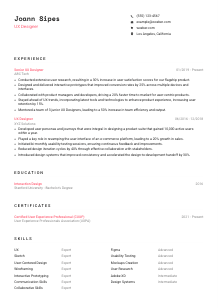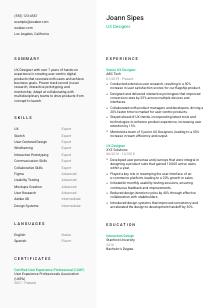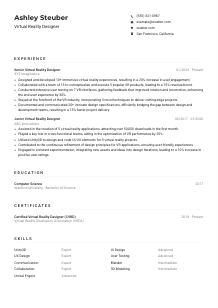UX Designer CV Example
Crafting user journeys, but your CV feels like a maze? Navigate this UX Designer CV example, designed with Wozber free CV builder. Learn how you can lay out your user-centric skills to sync with company needs, making your career path as intuitive and engaging as the interfaces you create!

How to write an UX Designer CV?
Welcome, innovative UX Designer, to your ultimate guide on crafting a CV that not only ticks all the boxes but also tells your unique story. The world of UX Design is dynamic, merging creativity with technology, and your CV should reflect this blend seamlessly. Using Wozber's free CV builder, you're about to embark on a journey to create a CV that's not only ATS-compliant but also resonates with who you are as a professional.
Ready to dive in and design a CV as intuitive and captivating as the digital products you create? Let's make your career aspirations a tangible reality!
Personal Details
Every masterpiece starts with a blank canvas, and your CV is no exception. Beginning with the Personal Details section, let's make sure it sets the right tone for the entire document.
1. Brand Yourself with Your Name
Think of your name as the title of your own brand story. It should grab attention, so use a font that's clean and large enough to stand out but not overwhelm.
2. Align with Your Profession
Directly beneath your name, shine a light on your profession by matching it to the job title "UX Designer". This is a subtle yet powerful way to tell hiring managers, 'I'm exactly who you're looking for.'
3. Essential Contact Info
Make it simple for potential employers to reach out to you. Include your phone number and a professional email address using the firstname.lastname@email.com format. Double-check for accuracy, as this is your digital handshake.
4. Location, Location, Location
Mentioning "Los Angeles, California" not only aligns with the job's geographical requirement but also reassures the employer of your availability and readiness to take on the role without the hurdles of relocation.
5. Digital Footprint
A LinkedIn profile or a personal portfolio website is your digital portfolio. Ensure it's updated and mirrors the dedication and creativity you bring to the UX field.
Takeaway
The Personal Details section introduces you to potential employers. It's crucial to be succinct yet impactful, ensuring each piece of information serves a purpose in aligning with the UX Designer position you're targeting. View this section as the springboard that propels the reader into the narrative of your professional journey.





Experience
The Experience section is where you get to tell your story - the challenges you've tackled, the designs you've brought to life, and the users you've delighted. Let's sculpt this section to highlight not just what you've done, but how well you've done it.
- Conducted extensive user research, resulting in a 30% increase in user satisfaction scores for our flagship product.
- Designed and delivered interactive prototypes that improved conversion rates by 25% across multiple devices and interfaces.
- Collaborated with product managers and developers, driving a 20% faster time to market for user‑centric products.
- Stayed ahead of UX trends, incorporating latest tools and technologies to enhance product experience, increasing user retention by 15%.
- Mentored a team of 3 junior UX Designers, leading to a 50% increase in team efficiency and output.
- Developed user personas and journeys that were integral in designing a product suite that gained 10,000 active users within a year.
- Played a key role in revamping the user interface of an e‑commerce platform, leading to a 20% growth in sales.
- Initiated bi‑monthly usability testing sessions, ensuring continuous feedback and improvements.
- Reduced design iteration cycles by 40% through effective collaboration with stakeholders.
- Introduced design systems that improved consistency and accelerated the design‑to‑development handoff by 30%.
1. Deconstructing the Job Requirements
First things first, overlay your experience with the job description. For instance, "Conducted extensive user research" directly responds to the job's need for someone proficient in usability testing and user needs analysis.
2. Present with Structure
Organize your professional history in reverse-chronological order. Clearly list your job title, the company's name, and your period of employment. This layout is not just reader-friendly but also ATS-compliant.
3. Accomplishments That Speak Volumes
Detail your achievements, ensuring they mirror the job requirements. Use impactful verbs and quantify results where possible, such as "Led a 20% faster time to market for user-centric products" to demonstrate effective collaboration and project impact.
4. Numbers Tell the Tale
Quantifying your impact provides a tangible measure of your success. For instance, "designed and delivered interactive prototypes that improved conversion rates by 25%" vividly illustrates your direct influence on business outcomes.
5. Relevance is Key
Tailor your experiences to align with the role's requirements. Irrelevant achievements, however impressive, might distract the hiring manager from your fittingness for the UX Designer position.
Takeaway
Leveraging the Experience section to showcase your relevant professional journey is paramount. It's about painting a picture of a proactive, result-driven UX Designer who not only meets the job requirements but exceeds them. Make every word count, and ensure your experiences resonate with the role you aspire to.
Education
In the realm of UX Design, your educational background provides the theoretical underpinning to your practical skills. Here's how to ensure your Education section bolsters your candidacy.
1. Highlight the Essentials
If the job specifies "Bachelor's degree in UX Design, Interaction Design, or related field," it's crucial to list your degree accordingly. This directly aligns with the employer's specified requirements.
2. Keep It Straightforward
List your highest degree first, followed by any relevant coursework if you're early in your career. Use a simple format that includes the degree, field of study, institution, and graduation year.
3. Match the Job's Needs
"Bachelor's Degree in Interaction Design" precisely matches the job's educational prerequisites, making it immediately clear that your academic background is a perfect fit.
4. Relevant Courses and Projects
For roles where specific skills are paramount, mentioning relevant coursework or projects can be beneficial, particularly if you're new to the field or the role demands niche expertise.
5. Additional Achievements
If you've excelled academically or have been part of relevant extracurricular activities, briefly mention these. For senior roles, prioritize information directly relevant to the job's responsibilities.
Takeaway
Crafting an Education section that reflects a strong foundation in UX design is crucial. It reassures the employer of your capability to transition theoretical knowledge into practical outcomes. Make sure this section is clear, concise, and directly relevant to the UX Designer role you're aspiring for.
Certificates
In the ever-evolving field of UX Design, staying abreast of the latest trends and tools is key. Certifications can showcase your dedication to professional growth and expertise.
1. Role-Relevant Certifications
While the job description may not explicitly demand certifications, listing ones like "Certified User Experience Professional (CUXP)" immediately signals your commitment to UX excellence and continuous learning.
2. Prioritize Pertinence
Select certifications that closely align with the job description or elevate your expertise in the UX field. This emphasizes your dedication to the profession and your proactive approach to skill enhancement.
3. Date Details
Mentioning the dates of acquisition ("2021 - Present") for ongoing or recent certifications can illustrate your up-to-date knowledge and active participation in the UX community.
4. Keep Learning
UX Design is a dynamic field, rewarding those who stay curious and informed. Regularly seek out new certifications that align with your career aspirations and the evolving demands of the industry.
Takeaway
Showcasing relevant certifications is a testament to your commitment to your personal and professional growth in UX Design. It's a tangible way to demonstrate your up-to-date expertise and readiness to contribute at the highest levels. Let this section reflect your journey of continuous learning and advancement.
Skills
Your skills section is a concise showcase of your UX design toolkit. In a glimpse, it should communicate not just your capability but your proficiency in the skills most relevant to the job at hand.
1. Extract and Match
Start by dissecting the job description to spot specific skills requested, such as "Proficiency in design tools such as Sketch, Figma, Adobe XD." Align your skills section to reflect these, cementing your status as a well-equipped UX Designer.
2. The Perfect Mix
Strike a balance between hard skills, like wireframing and prototyping, and soft skills, such as collaboration and communication. This offers a holistic view of your capabilities, portraying you as a well-rounded candidate.
3. Less Is More
While it's tempting to list every skill you possess, focus on those most relevant to the job. An overcrowded skills section can dilute the impact of your core competencies.
Takeaway
Strategically curating your skills section can significantly elevate your CV. It's not just about listing what you can do; it's about highlighting the skills that make you an irresistible choice for the UX Designer role. Tailor this section to mirror the job description, and you're on your way to capturing the hiring manager's attention.
Languages
In an increasingly global industry, the ability to communicate across cultures is a valuable asset. Let's ensure your language skills are portrayed as the strengths they truly are.
1. Meet the Requirements
The job description mentions "Strong English communication skills needed." Clearly stating your proficiency level in English as "Native" directly aligns with this requirement, reinforcing your suitability for the role.
2. Additional Languages
Even if not explicitly required, additional languages can enhance your appeal, especially in roles involving diverse user groups or global teams. List these languages, emphasizing your versatility and global mindset.
3. Honest Proficiency
Accurately represent your language proficiency to set clear expectations. Whether you're "Fluent" or have "Basic" knowledge, honesty here builds trust and credibility.
4. Contextual Relevance
Consider the role's scope and the company's market. For roles that might involve communication with international clients or teams, your multilingual skills could provide a distinct advantage.
5. Global Perspective
Understanding and communicating in more than one language opens doors to richer user insights and broader perspectives, invaluable in crafting user experiences that resonate on a global scale.
Takeaway
Your language skills can significantly amplify your CV, providing snapshots of your global mindset and cultural adaptability. Clearly showcasing these abilities, consistent with the job requirements, can set you apart in the competitive field of UX Design. Remember, every language you know is a pathway to understanding a wider user base.
Summary
Your summary is the elevator pitch of your CV, designed to captivate and convey your professional identity. Here's how to refine it to resonate deeply with the role you aspire to.
1. Capturing the Job's Soul
Dive into the essence of the role by linking your professional narrative with the job's requirements. For instance, "UX Designer with over 7 years of hands-on experience in creating user-centric digital products" showcases both experience and alignment with user-centric design principles.
2. Begin with Who You Are
Introduce yourself through the lens of your profession and expertise. This isn't just about your job title; it's about the unique mix of skills, experiences, and passions you bring to the table.
3. Highlight Your Unique Contributions
Elucidate your major accomplishments and specify how they've impacted your teams and projects. This isn't boasting; it's providing concrete evidence of your ability to make a difference in the UX realm.
4. Conciseness Wins
Craft a summary that's both compelling and concise. Aim for 3-5 lines that encapsulate your essence as a UX Designer. This teaser sets the stage for the detailed narrative that unfolds in your CV.
Takeaway
A well-crafted summary section is your chance to make a memorable first impression. It should encapsulate what you offer as a UX Designer, aligning closely with the role's requirements while highlighting your unique professional identity. Keep it succinct, relevant, and impactful, setting the tone for the narrative you wish to tell.
Launching Your UX Designer Journey
Congratulations on completing this guide! With each section carefully tailored and every tool from Wozber's free CV builder at your disposal, from ATS-friendly CV templates to ATS optimisation and the ATS CV scanner, you're now equipped to create a CV that not only meets the expectations of today's hiring managers but also showcases your true professional caliber. Your journey as a UX Designer is filled with endless possibilities. Let your CV open the doors to opportunities where you can continue to innovate, create, and inspire.
Here's to crafting not only user experiences but also a career path that fulfills and excites you. Dive in, the world of UX awaits your unique contributions!

- Bachelor's degree in UX Design, Interaction Design, or a related field.
- Minimum of 3 years of professional experience in UX Design.
- Proficiency in design tools such as Sketch, Figma, Adobe XD, or equivalent.
- Strong understanding of user-centered design principles and methodologies.
- Excellent interpersonal and communication skills to collaborate effectively with multidisciplinary teams.
- Strong English communication skills needed.
- Must be located in Los Angeles, California.
- Conduct user research, usability testing, and analysis to gain insights into user needs and behaviors.
- Design and deliver wireframes, mockups, and interactive prototypes for various devices and interfaces.
- Collaborate with cross-functional teams, including product managers, developers, and stakeholders, to ensure a user-centric approach to product development.
- Stay updated on current UX trends, tools, and emerging technologies to continually enhance the product experience.
- Provide feedback and mentor junior UX Designers to foster a collaborative and growth-oriented design environment.















